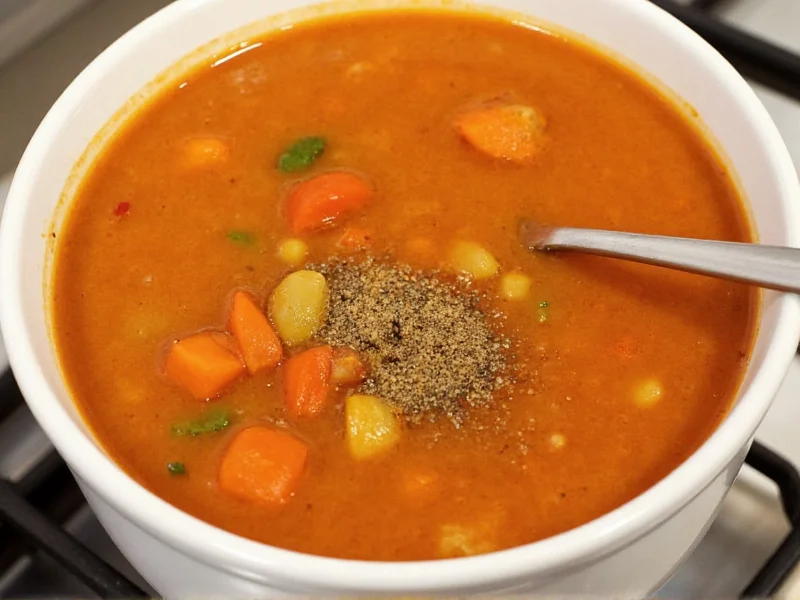Transforming ordinary vegetable soup into a flavor masterpiece requires understanding spice timing, combinations, and balance. Many home cooks make the mistake of adding all spices at once or relying solely on salt, resulting in one-dimensional broth. The secret lies in strategic layering—introducing different flavor elements at specific cooking stages to build complexity without overwhelming the natural sweetness of vegetables.
The Science Behind Vegetable Soup Spicing
Vegetable soup presents unique flavor challenges compared to meat-based broths. Without the natural umami of bones or meat, achieving depth requires thoughtful spice application. Vegetables contain varying levels of natural sugars and bitter compounds that interact differently with spices. Root vegetables like carrots and parsnips benefit from warm spices early in cooking, while delicate greens need bright finishes. Understanding these dynamics prevents flavor clashes and creates harmony.
Essential Spice Timing Techniques
When spicing vegetable soup, timing determines whether flavors integrate smoothly or become harsh. Follow this professional sequence for optimal results:
| Cooking Stage | Recommended Spices | Application Method | Why It Works |
|---|---|---|---|
| Sautéing Base | Cumin, coriander, smoked paprika | Add to hot oil before vegetables | Releases essential oils, creates flavor foundation |
| Early Simmer | Bay leaves, thyme, rosemary | Add with liquid, remove before serving | Infuses deep flavors without bitterness |
| Mid-Cooking | Tomato paste, miso, soy sauce | Stir in after 15 minutes of simmering | Develops umami without burning |
| Finishing Touch | Lemon zest, fresh dill, sherry vinegar | Add just before serving | Preserves bright, volatile flavor compounds |
Regional Flavor Profiles That Work
Instead of generic "soup seasoning," consider these culturally-inspired combinations that complement vegetable soup's versatility:
- Mediterranean Approach: Oregano + lemon + garlic + red pepper flakes (add lemon juice at the end)
- Asian-Inspired: Ginger + star anise + tamari + rice vinegar (use tamari instead of salt)
- North African Twist: Cumin + coriander + cinnamon + preserved lemon (add cinnamon early, preserved lemon at end)
- Eastern European Style: Dill + caraway + marjoram + apple cider vinegar (add caraway with base vegetables)
Each profile creates distinct flavor architecture while respecting vegetable integrity. The Mediterranean approach works particularly well with tomato-based vegetable soups, while the Asian-inspired version elevates clear broths with root vegetables.
Acidity: The Secret Weapon for Bland Soup
When vegetable soup tastes flat, the solution is rarely more salt—it's usually missing acidity. Professional chefs use acid to brighten flavors and create balance. Add these acids at the very end of cooking:
- Lemon or lime juice (1-2 tsp per quart)
- Apple cider vinegar (½-1 tsp per quart)
- Sherry vinegar (¼-½ tsp per quart for sophisticated depth)
- White wine (¼ cup per quart, simmered 2 minutes)
Acid doesn't make soup taste sour—it makes other flavors pop. Start with small amounts, stir well, and taste before adding more. The perfect balance creates that "something's different" effect without identifiable sourness.
Umami Builders for Depth Without Meat
Vegetable soup often lacks the savory depth of bone broths. These plant-based umami boosters solve that problem without meat:
- Dried mushrooms: Soak 2-3 dried shiitakes in hot water, add both mushrooms and liquid
- Miso paste: Whisk 1 tbsp into ¼ cup broth, then stir into soup off-heat
- Tamari: Substitute for salt (½ tbsp per quart)
- Nutritional yeast: 1-2 tbsp for cheesy depth
- Tomato paste: Cook with aromatics until brick-red (5-7 minutes)
For best results, combine two umami sources—like tomato paste during sautéing plus miso at the end. This creates layered savoriness that makes vegetable soup satisfyingly rich.
Avoiding Common Spicing Mistakes
Even experienced cooks make these vegetable soup seasoning errors:
- Adding dried herbs too late: Dried herbs need 20+ minutes simmering to mellow; add early
- Overusing garlic powder: Creates artificial flavor; use fresh garlic instead
- Ignoring vegetable sweetness: Balance sweet vegetables with acid, not just more salt
- Seasoning only at the end: Salt in stages—¼ when sautéing, ½ mid-simmer, final ¼ at end
- Using old spices: Replace ground spices every 6 months for vibrant flavor
Troubleshooting Flavor Problems
Rescue your soup with these targeted fixes:
- Too bland? Add ¼ tsp onion powder + 1 tbsp acid + pinch of red pepper flakes
- Too bitter? Stir in 1 tsp maple syrup + 1 tbsp lemon juice
- Flat flavors? Add 1 dried arbol chili while simmering (remove before serving)
- Over-salted? Add raw potato chunks (remove after 10 minutes) or dilute with unsalted broth
- One-note flavor? Finish with fresh herb oil (blend ¼ cup herbs + 2 tbsp oil)
Perfecting Your Vegetable Soup Seasoning
Mastering vegetable soup spicing requires attention to detail at every stage. Begin by building flavor foundations with properly cooked aromatics, layer spices according to their chemical properties, and always finish with brightness. Remember that the best vegetable soup seasoning enhances rather than masks the natural flavors of your ingredients. With these techniques, you'll create vegetable soup with restaurant-quality depth that satisfies even the most discerning palates—no meat broth required.











 浙公网安备
33010002000092号
浙公网安备
33010002000092号 浙B2-20120091-4
浙B2-20120091-4